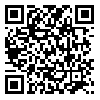Volume 68, Issue 2 (5 2010)
Tehran Univ Med J 2010, 68(2): 128-136 |
Back to browse issues page
1- , kohan@uswr.ac.ir
Abstract: (9427 Views)
Background: Constraint-Induced movement therapy (CIMT) is a promising treatment for improving upper limb function in adults after stroke and traumatic brain injury. It involves constraint of the less affected limb and intensive practice with the more affected limb. The purpose of this study on children with hemiplegic cerebral palsy (CP) was to evaluate the effects of CIMT on upper extremity and to make a comparison with conventional treatment.
Methods: I a randomized clinical trial twelve children (seven females, five males aged between 48 and 72 months with mean±standard deviation of 59.91±9.15mo) were randomly assigned in two groups. An intensive occupational therapy program including five hours per day for 21 consecutive days was performed for all of them, while less affected limbs were placed in sling for immobilization. Before and after intervention, upper extremity function, spasticity, and motor neuron excitation were evaluated by means of peabody developmental motor scales, modified Ashworth scale, and H reflex and H/M ratio, respectively.
Results: The children who received CIMT did not improved their ability to use their hemiplegic hand significantly more than the children in the control group (p>0.05). However, reports of caregivers and clinical observations showed increases in more affected limb frequency of use and quality of movement.
Conclusion: Results suggest that the use of CIMT needs to more studies and should be considered experimental in children with hemiplegic CP
Keywords: Constraint-Induced movement therapy (CIMT), Occupational Therapy, fine motor skills, cerebral palsy, children, rehabilitation, peabody developmental motor scales
| Rights and permissions | |
 |
This work is licensed under a Creative Commons Attribution-NonCommercial 4.0 International License. |


